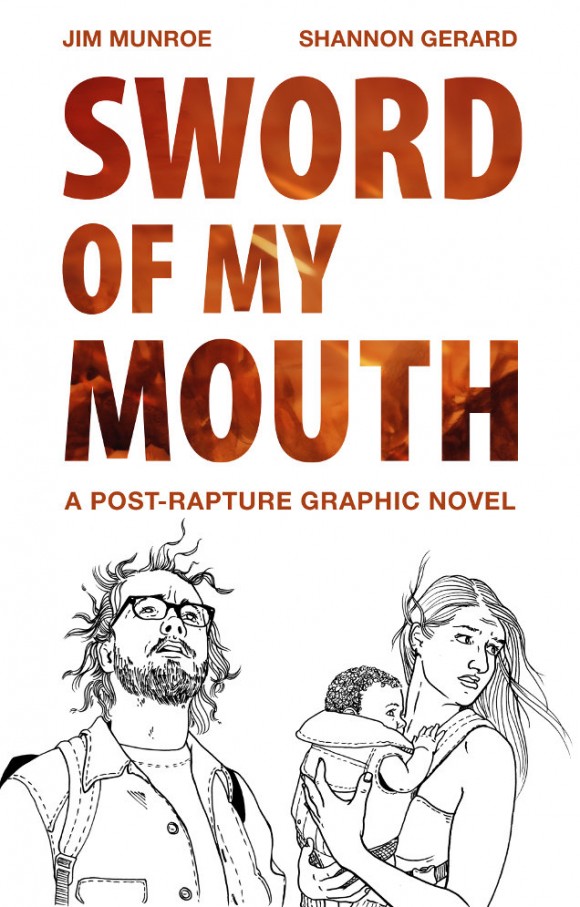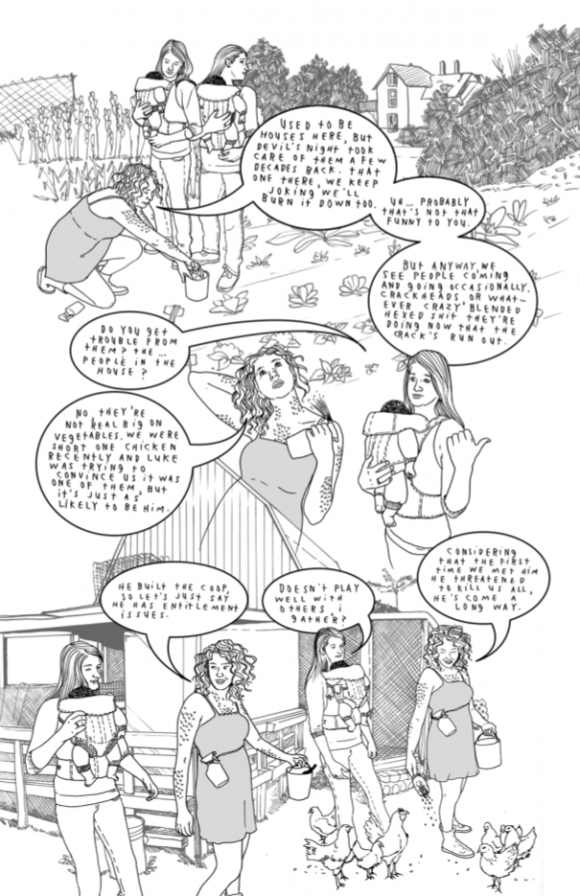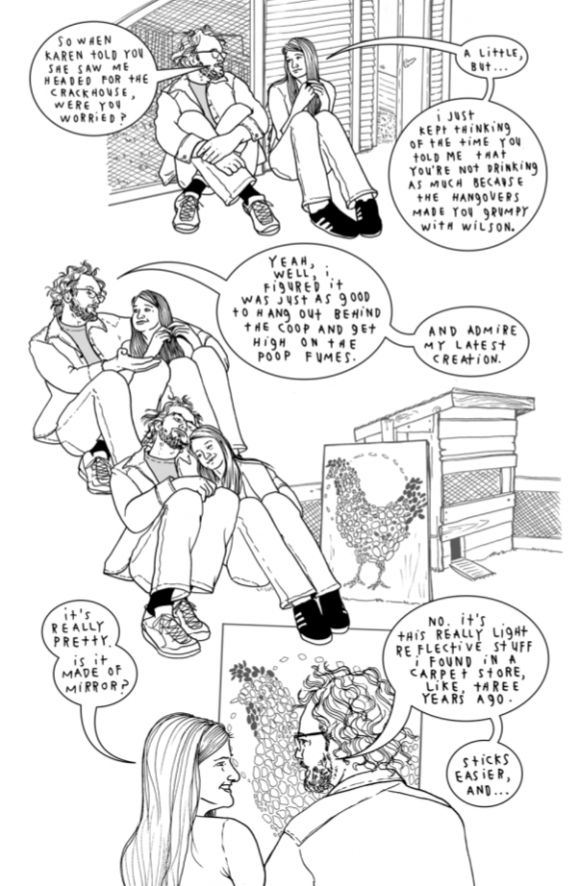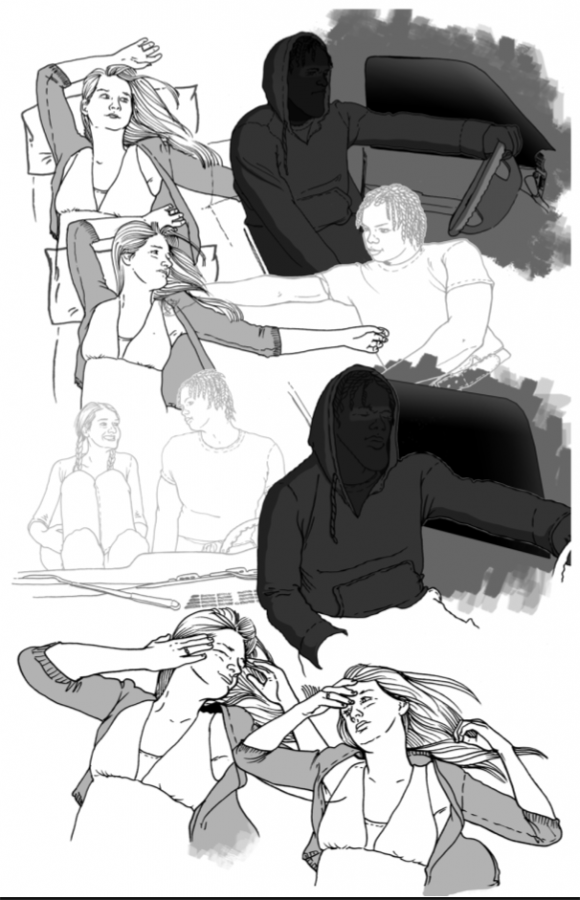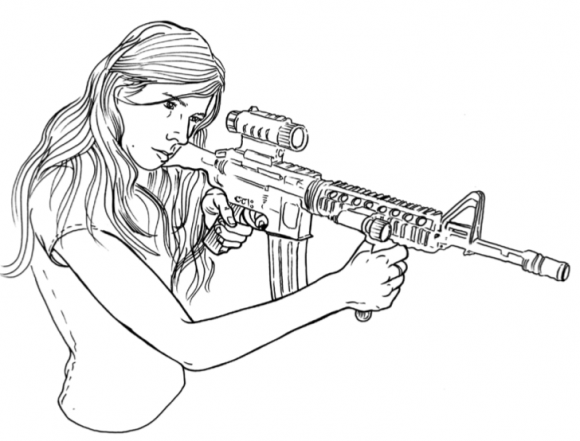Shannon Gerard is an illustrator, designer and artist based out of Toronto, Ontario. Novelist and indie publishing guru, Jim Munroe, recently tapped Gerard to pen the images for the latest installment of his graphic novel series, Sword of My Mouth. In Munroe’s post-rapture universe, literal magic is possible when a “field” is lifted from the earth by a mysterious entity, now making anything in the human imagination possible, like casting spells, mutating oneself into a fish-person and the rapture of millions of believers up into the stratosphere. The first installment, Therefore Repent! took place in Chicago, with familiar locales and landmarks playing a large role in the story. SoMM continues this theme by adopting the people and places of Detroit to tell the story of what happens in a world where the impossible is possible and who’s playing the angles to exploit the situation.
I spoke with Gerard via email regarding her artistic process, collaboration and urban gardening. Enjoy.
A: How did the SoMM project get started?
SG: Jim asked me to give him some feedback about Therefore Repent! way back before it was published and I was pretty excited about the story because I’d grown up in Christian youth group watching the Left Behind movies and hearing pretty serious takes on the Rapture. When SoMM came around, it was a really great opportunity for me to explore some of that weirdness and also address the humor in those childhood experiences through being part of Jim’s fictional world.
A: How much of the completed story did Jim bring to the table?
SG: I think he just knew that he wanted the story to be set in Detroit and maybe had a loose idea about the characters. Early on we took a research trip to the city with a very sketchy framework in place. I wanted to take as many pictures of the city as possible and Jim (I think) wanted to meet people and find out what issues were most important to the place for people really living there.
A huge leap for the story was seeing some of the urban gardens that exist in Detroit, especially the Catherine Ferguson Academy which is this amazing, fully producing farm with a wide range of vegetables, so many kinds of animals, a solar barn, a little orchard and an apiary. It is smack in the centre of a seriously depressed urban area. I’m guessing it is like 3 or more acres big. Amazing. The volunteers working there on the day we visited were incredibly open to showing us around and gave us so much to think about self-sustainability.
One of the mottos I noticed on a lot of signage in Detroit was “Say nice things about Detroit!”– as if people living there really believe in the power of stories to transform popular (and sometimes really wrong) opinions about places. Almost without exception, the folks we met were so happy and so eager to talk about their city to us.
So those research trips (we took 2) helped the story in SoMM to evolve.
A: How much of the obligation was on you to tell the story visually?
SG: I would not call it obligation since the dynamic between Jim and I while working was really open and equal. I never felt it was Jim’s story that I was interpreting or trying to “get right.” Since he involved me so much right from the beginning by inviting me to drive to Detroit with him, I felt like I understood his way of creating and knew where the tensions and plots and motivations of the book came from. We talked a lot about the characters and their relationships since that is so much the focus in my own work and it was really great how much freedom I had to communicate those emotional sub-plots and back-stories through the images.
Also, Jim was really open to my panel-less structure. Even though he gave me a script with traditional panel breakdowns, he was really into just letting me work all of his described panels into a page without organizing them so linearly. In a few instances, he gave me really specific instructions for layouts and those ended up being some of my favorite pages. I think he will not like the word “instructions” though since there was never a feeling of him telling me what to do. I had so much freedom and he even rewrote some dialogue to accommodate my drawings! Who gets that chance as an illustrator?! In a word, (the collaborative process was) amazing. I am so lucky to have such a great first experience with collaboration.
A: Can you describe your work process? Do you work with models? Any computer programs involved?
SG: I work with models who actually act out the story in improvised segments as I take pictures. I give them a lot of background information about their characters and relationships but we don’t read the dialogue at all since I do not want the images to look scripted. Candid human moments between the models are what is most important to me in drawing, so this process allows me to capture as much of that quality as I can. There is also everything the models themselves bring (as improv actors) to the story that shows up in the drawings. By not reading the script but just playing the story out, I was able to draw upon so much that felt real and in that way told my own version of the story, along with and in support of Jim’s script. Lucky for me that he never felt threatened or weird about that but embraced it as part of the book.
After I have like 500 more photos than I actually need, I go through them and choose the ones that reveal or represent the best moments from people. So many times, I am compositing pictures from multiple shoots because the models are rarely all available at the same time. Then I make photo-based mock ups of the pages and print and trace those photos as drawings. (Using my beloved micron 0.2 pens. I went through literally hundreds of those pens on this book!) My favourite example of the compositing of separate shoots into one drawing was a page on which two characters hug. The models in that embrace could not meet on the same day, so in both shoots, they hugged a stand-in. Then later I drew them hugging each other. The stand-in was the same person in each shoot, so if you could see behind the curtain where he was edited out, you’d have a drawing of him hugging himself.
I don’t draw the pages as they look in the book but work on individual frames. Then I use photoshop to composite the drawings into the layouts that appear in the final story. It is a time consuming process to not draw the pages as whole compositions, but I like how much freedom it gives me to make choices about character relations and page design as I go along.
A: When did you do your first comic and was there a particular artist that inspired you to play with that form?
I guess I started working on comics in 2003 or so when I made this stupid inside-joke static type comic about the bookstore I worked at. That embarrassing PoS was called Five Finger Discount.
My inspiration to make comics did not really come from another visual artist but from essayist Annie Dillard. I was drawing a lot and also writing a lot and then read a piece in which she described the realization that she could be a writer without being a novelist. She said that deciding to write creative non-fiction and poetry felt like switching from a single reed instrument to a full orchestra. That made such exact sense to me and I started to play with mixing text and images and with making artist’s books.
A: How does working in a short form compare to a full-length graphic novel?
SoMM is my first long form project. It was a huge challenge to work for so long on telling one story, but I am lucky to have done it as a collab. I’m not sure I would have had the faith in my own work over such a long period.
A: Did you study any graphic novels before starting work on SoMM? Any influences?
SG: I didn’t study any works in particular but I looked to my heroes for a lot of inspiration: Rutu Modan, Jillian Tamaki, and Lynda Barry. I also read a lot of my favorite prose to keep up the moony, emotional floatiness I like while drawing: Miriam Toews, Michael Ondaatje and Kathleen Norris.
A: How long did the it take to complete the work?
SG: Over a year. I clocked around 1000 hours.
A: Do you have any plans for future graphic novels?
SG: Yes, I am working on a collection called Unspent Love; Or, Things I Wish I Told You. Not a long form story though. It is a collection of small prose-poemy vignettes.
There is also a slow burning story in the works about my father’s childhood.
And I am also trying to tie up, once and for all, my older series Hung by printing a fourth story over top of the first story. A printer’s error in 2005 ended up giving me an extra 200 or 300 copies of Hung #1, which I am now so embarrassed by (that’s good right?), so I am resolving some of that anxiety by using a letterpress to overprint Issue 4 on top of the older books.
Sword of My Mouth is available now and can be purchased here.












